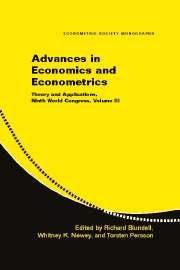Book contents
- Frontmatter
- Contents
- Contributors
- Introduction by the Editors
- 1 Identification of Nonadditive Structural Functions
- 2 Nonadditive Models with Endogenous Regressors
- 3 Heterogeneity and Microeconometrics Modeling
- 4 Heterogeneous Choice
- 5 Modeling Heterogeneity
- 6 Inference with Weak Instruments
- 7 Empirical Likelihood Methods in Econometrics: Theory and Practice
- 8 Weak Instruments and Empirical Likelihood: A Discussion of the Papers by D. W. K. Andrews, J. H. Stock, and Y. Kitamura
- 9 Estimating Continuous-Time Models with Discretely Sampled Data
- 10 Variation, Jumps, and High-Frequency Data in Financial Econometrics
- 11 Discussion of Aït-Sahalia and Barndorff-Nielsen and Shephard
- 12 Understanding Bias in Nonlinear Panel Models: Some Recent Developments
- 13 Fixed and Random Effects in Nonlinear Panel Data Model: A Discussion of a Paper by Manuel Arellano and Jinyong Hahn
- Index
- Titles in the series
2 - Nonadditive Models with Endogenous Regressors
Published online by Cambridge University Press: 05 January 2013
- Frontmatter
- Contents
- Contributors
- Introduction by the Editors
- 1 Identification of Nonadditive Structural Functions
- 2 Nonadditive Models with Endogenous Regressors
- 3 Heterogeneity and Microeconometrics Modeling
- 4 Heterogeneous Choice
- 5 Modeling Heterogeneity
- 6 Inference with Weak Instruments
- 7 Empirical Likelihood Methods in Econometrics: Theory and Practice
- 8 Weak Instruments and Empirical Likelihood: A Discussion of the Papers by D. W. K. Andrews, J. H. Stock, and Y. Kitamura
- 9 Estimating Continuous-Time Models with Discretely Sampled Data
- 10 Variation, Jumps, and High-Frequency Data in Financial Econometrics
- 11 Discussion of Aït-Sahalia and Barndorff-Nielsen and Shephard
- 12 Understanding Bias in Nonlinear Panel Models: Some Recent Developments
- 13 Fixed and Random Effects in Nonlinear Panel Data Model: A Discussion of a Paper by Manuel Arellano and Jinyong Hahn
- Index
- Titles in the series
Summary
INTRODUCTION
In the last fifteen years there has been much work on identification of causal effects under weak conditions in settings with endogeneity. Earlier, researchers focused on linear systems with additive residuals. However, such systems are often difficult to motivate by economic theory. In many cases it is the nonlinearity of the system and the presence of unobserved heterogeneity in returns (and thus nonadditivity in the residuals) that leads to the type of endogeneity problems that economists are concerned with. In the more recent literature researchers have attempted to characterize conditions for identification that do not rely on such functional form or homogeneity assumptions, instead relying solely on assumptions that are more tightly linked to economic theory. Such assumptions typically include exclusion and monotonicity restrictions and (conditional) independence assumptions.
In this paper I will discuss part of this literature. I will focus on a two-equation triangular (recursive) system of simultaneous equations with a single endogenous regressor and a single instrument. Although much of the earlier literature on simultaneous equations focused on larger systems (in fact, much of the theoretical literature studied systems with an arbitrary number of endogenous regressors and an arbitrary number of instruments despite the rare occurrence of systems with more than two endogenous variables in empirical work and the practical difficulty of even finding a single credible instrument), many applications have this two-equation form and the framework is sufficiently rich for discussing the nature of the identification problems that are studied here.
- Type
- Chapter
- Information
- Advances in Economics and EconometricsTheory and Applications, Ninth World Congress, pp. 17 - 46Publisher: Cambridge University PressPrint publication year: 2007
- 5
- Cited by



